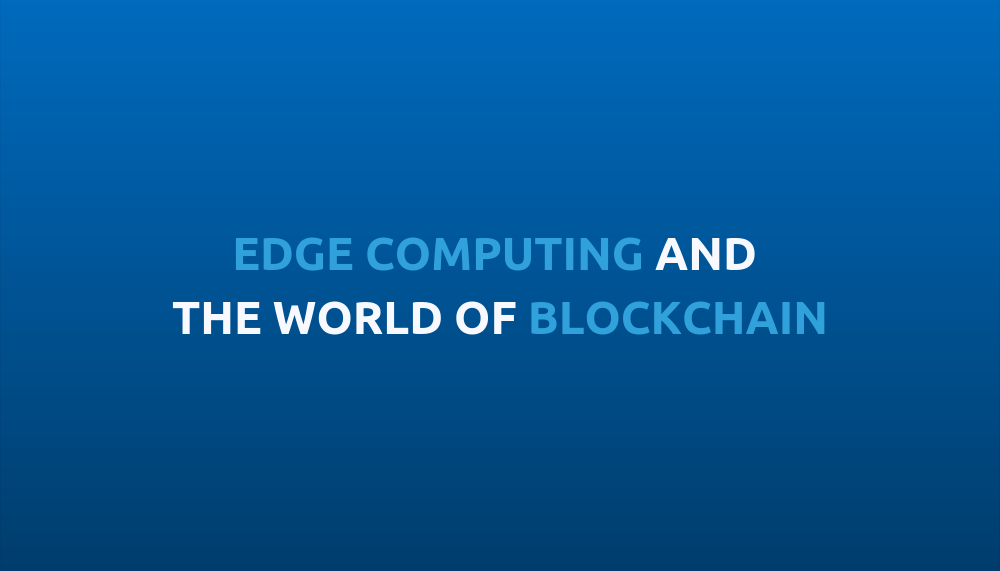Edge Computing and the World of Blockchain

The answer to this question will help to analyze the most important issue of future ICT (Information & Communication Technology): ‘How far can Edge Computing go?’.
This will eventually guide the reshaping of industrial structure and yes, the future of cloud computing, fog computing, IoT, and even blockchain will all very much depend on this answer.
What is Edge Computing?
‘Edge Computing’ is a small-scaled mesh network that transfers processed or saved data to a central data center or cloud storage. Technically, it can be understood as a data processing base that is built at the gateway point. The argument lies in where it should be built, in other words where the end network with computing power should be. There are basically two sides to this argument.
One side: It’s a waste of time to allow all the devices to be connected to the internet to actually compute. It’s argued that setting a network coverage amongst a certain number of devices for an edge computing system only makes sense. Also includes improving the current gateway whilst maintaining low-power for other connected devices in order to put efficiency first.
The other side: All devices must be able to compute to realize a legitimate IoT environment. Simple devices still need enough computing power to differentiate significant data, therefore in the end, the data transferred to cloud storage can only be considered significant. Meaning it needs an outrageous number of operating devices, argued by component or system manufacturers.
Too Many ‘Things’
There are basically two things we need to take into account:
- Number of things connected to the internet & use of energy
- Use of energy & price of communication and operating costs
Let’s first take the number of devices connected to the internet and energy into account. Market research institutions forecasted that the number of IoT devices will exceed 50 billion in 2022 (we’re at 20 billion at the moment, phew!). Taking the boost of 5G into account, which seems to be the main factor for the big number… so thanks to 5G, it’s not really just about the numbers anymore.
Then there’s energy. There are again two costs to consider here. Communication costs caused by simple sensor sending data and operation costs by smart devices processing data. You may think the costs might be similar, but 50 billion devices… this isn’t something that you can calculate off the top of your head.
Each device has different qualities and details of request. Some must be part of smart gateways. Some data centers, like cars which are basically moving computers. This is critical for building a smart city. What about smart home and maybe even a fridge or a tv? Can you see the big picture already?
Blockchain
When you actually think about it, this whole thing is just massive. Let’s bring ourselves back to ‘Edge Computing’ once again. It all began to solve the issues of cloud computing. We needed to gather all the data together, so we did – but now it’s just out of our hands. Plus, the IoT devices – now the central data storage is unable to handle the amount of all the data. Even now, the central data storage isn’t managing all the data in one place.
Will deploying edge computing in different areas solve everything? As much as we want to think that way, it doesn’t seem possible at all. Again, 50 billion isn’t just a number. This is the crucial limit of the central directing system we’ve discussed earlier.
Therefore, the need for automatic management of networks is becoming critical, and the most effective way is considered to be understanding ‘Distributed Ledger Technology’ – in a familiar word – Blockchain (blockchain is in fact a form of DLT). Smart Contracts in each device manage communication between devices, meaning there is no middleman. Therefore, the entire mesh network is safe and self-strengthened despite the size.
Despite Where Edge Computing is Deployed
Back to the beginning, the answer to this question ‘How far can edge computing go?’ will most definitely lead to the reshaping of industrial structure – which then is really about who will earn the most (or even more than some others at least). Wherever edge computing is deployed, it will allow a countless number of devices to communicate and form an organism. The only method that can control that massive system, is blockchain – at least for now.
Don’t forget though, it doesn’t mean that blockchain will replace the existing legacy system.
System via blockchain should be seen as ‘nature’, therefore the need to oversee and manage this, still exists. The existing enterprise applications will still be placed under ‘nature’. Let’s put it in a literary expression: This is like ‘God/Nature/Civilization’ and blockchain is – yes, we know it now don’t we? – ‘nature’ here.
If you would like to be updated on our latest blogs, please sign up here!
